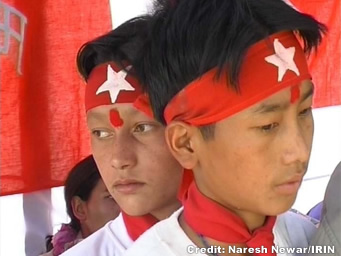|
 |
Child
soldiers in Nepal |
|
|
|
Child
recruitment in South Asian conflicts: A Comparative analysis of Sri Lanka,
Nepal and Bangladesh
|
 |
Executive
Summary
The
causes and trajectories of existing conflicts in Sri Lanka and Nepal demonstrate
the failure of states to seriously address the underlying causes of social
unrest. The idea that the state is prejudiced against a particular ethnic
group, as in Sri Lanka, or against a particular class, as in Nepal, is
used by non-state actors to justify the continuation of conflict in which
children are inevitably targeted. The primary fault line in Bangladesh
relates to the notion of Bangladeshi identity and the role of Islam, but
although outbreaks of religious terrorism have taken place in Bangladesh,
there has been no outbreak of full-scale conflict.
 |
| Child
supporters of the Maoists - many are kidnapped or coerced into serving
with the rebels
Despite
the international focus on protection of children in armed conflict, there
remains a disturbing paucity of information about the actual use of and
impact of conflict on children in Sri Lanka and Nepal. |
|
Attempts
at gauging the number of children within the ranks of the Liberation Tigers
of Tamil Eelam (LTTE) in Sri Lanka only began in 2001 and there is little
information on child soldiers within the Communist Party of Nepal (Maoist)
(CPN(M)).
In
Bangladesh, in the absence of any systematic research into either the use
of children by mastans or indoctrination by madrassas, assessment of the
use of children by armed groups remains largely impressionistic and anecdotal.
However, it is possible to put together some sort of composite picture
on the use of children in conflicts in Nepal, Sri Lanka and Bangladesh.
The violation of children's rights during conflict has to be viewed in
the context of the state's failure to promote child rights in the community.
The rights of children in the three states examined are disregarded through
practices such as bonded labour and sexual trafficking. In each case the
line between 'childhood' and 'adulthood' is usually vague, and responsibilities
are acquired as a result of factors beyond chronological age. The failure
of the state to provide adequate and neutral education is another issue
in understanding conflict and child recruitment.
The correlation between
child recruitment and child labour in Nepal needs further investigation.
For Bangladesh, this report aims to flag up future areas of study to examine
linkages between the social and educational marginalization of street and
slum children and their vulnerability to use by armed, criminal syndicates.
Children
are inevitably among the first to be affected by conflict. Recruitment
by armed groups is only one of the ways in which the rights of children
are violated during a conflict situation. Children have been killed and
maimed during cross-fire and have been arbitrarily detained, tortured and
ill-treated by police and other state authorities throughout the conflicts
in Nepal and Sri Lanka.
The destruction wrought by these conflicts has
affected access to food and deprived children of key services such as education
and health care. The systematic violation of the fundamental rights of
children during conflict creates situations in which children are vulnerable
to both forced and voluntary recruitment by non-state armed groups. The
breakdown of protection mechanisms makes access to children easier and,
in some cases, joining an armed group becomes part of children's survival
strategy.
The
root causes of conflict in Sri Lanka and Nepal lie in failures by governments
to provide broad-based development and social justice. Angry at political
marginalization and government unaccountability, many older children in
Sri Lanka and Nepal joined the rebel movements voluntarily at first. But
as conflict deepened and security conditions deteriorated, younger children
became vulnerable to recruitment as a result of hunger, displacement and
the desire to protect their communities and for revenge.
In Bangladesh
a similar set of factors, namely poverty, isolation, lack of choice and
a visible absence of real democracy and equal opportunities, could push
children into the hands of radical elements and criminal mafias. Lessons
learnt from Sri Lanka and Nepal have direct resonance in Bangladesh. The
contested role of education in Nepal and Sri Lanka provides another lesson
for Bangladesh. This relates not only to access to standardized education
in remote and backward areas but also to the curriculum, medium of instruction,
and political involvement in budgetary and operational matters.
In Nepal,
the school curriculum has been the focus for tensions, and therefore carries
the potential to be as much 'part of the problem' as 'part of the solution'
in a number of ways. Timely attention to curriculum standardization in
Quomi madrassas could open up opportunities for many poorer students and
create disincentives for radicalization and recruitment by nonstate armed
groups.
Engagement
on the issue of child recruitment in Sri Lanka and Nepal requires a broad-based
approach. In both contexts social and economic inequalities are obvious
and democracy has failed to deliver on the basic needs of citizens, creating
conditions where protection mechanisms for children break down and allow
their recruitment by armed groups. Human rights organisations therefore
need to understand the social, economic and political factors and conflict
characteristics that lead to child participation, and protection mechanisms
should collectively address and prevent violence, abuse and neglect, exploitation
and discrimination and forced recruitment into armed groups. Advocacy responses
thus need to be both inclusive and strategic, identifying conflict trends
on the back of effective monitoring and research.
| Credit
ReliefWeb December 2006 |
 |
top
| Links |
 |
 |
 |
External
links |
|





